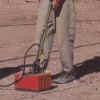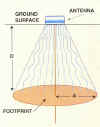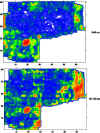| |
Abstract and Notes
|
|
Ground-Penetrating
Radar (GPR) Mapping as a method for planning excavation strategies,
Petra, Jordan
GPR Theory of Operation
 The
GPR Method The
GPR Method
- Radar pulses are generated at a surface antenna and then propagated
into the ground. When they encounter buried discontinuities (for
instance stones surrounded by sand or changes in the composition of
stratigraphic units), a portion of the radar energy is reflected back
to the surface and recorded again at the antenna.
- When the velocities of the radar travel-times are calculated they
can be converted to depth, making GPR a three-dimensional geophysical
tool.
 Recording
Radar Reflections Recording
Radar Reflections
- Antennas are moved along the ground surface in transects within a
grid.
- Many reflections are recorded per second and when they are plotted
in a vertical profile a two-dimensional vertical "slice" of
reflections in the ground is produced.
Figure
2

- When many transects are collected in a grid a three-dimensional data
base is obtained.
Figure
3

 Depth
of Penetration and Resolution Depth
of Penetration and Resolution
- The depth of penetration, and the resolution of buried features is
primarily controlled by the frequency of the antenna.
- At the "Lower Market" a 400 megahertz (MHz) frequency antenna
was used, which allows a maximum depth of penetration of about 3 meters
and can resolve features as small as about 10 cm in diameter.
Figure
11

 How
Materials in the Ground Affect the GPR Signal How
Materials in the Ground Affect the GPR Signal
- As radar energy moves through the ground, any discontinuity will reflect
energy back to the surface.
- Radar energy spreads out in a conical pattern as it moves into the
ground.
Figure
12

- As energy penetrates past a certain threshold it is absorbed by the
earth and spreads out until it is finally lost.
 Computer
Processing to Produce Images of Features in the Ground Computer
Processing to Produce Images of Features in the Ground
- Standard GPR processing produces two-dimensional vertical profiles
of each reflection transect.
- The high amplitude reflections, generated from buried materials with
a high physical or chemical contrast, show up as distinct black and
white reflections on the profiles. Areas of homogeneous
material with little contrast show up as shades of gray.
Figure
2

- A series of three-dimensional maps can be produced using what are
called amplitude time-slices.
- This processing method produces contoured maps of the relative amplitudes
of reflections in specific horizontal slices in the ground.
Figure
13

- Using this mapping method each time-slice becomes analogous to a map
of all materials in arbitrary excavation levels.
- Data from time-slice maps can also be imported into rendering programs
to produce three-dimensional images of reflections in the ground that
mimic the buried features
|
|





